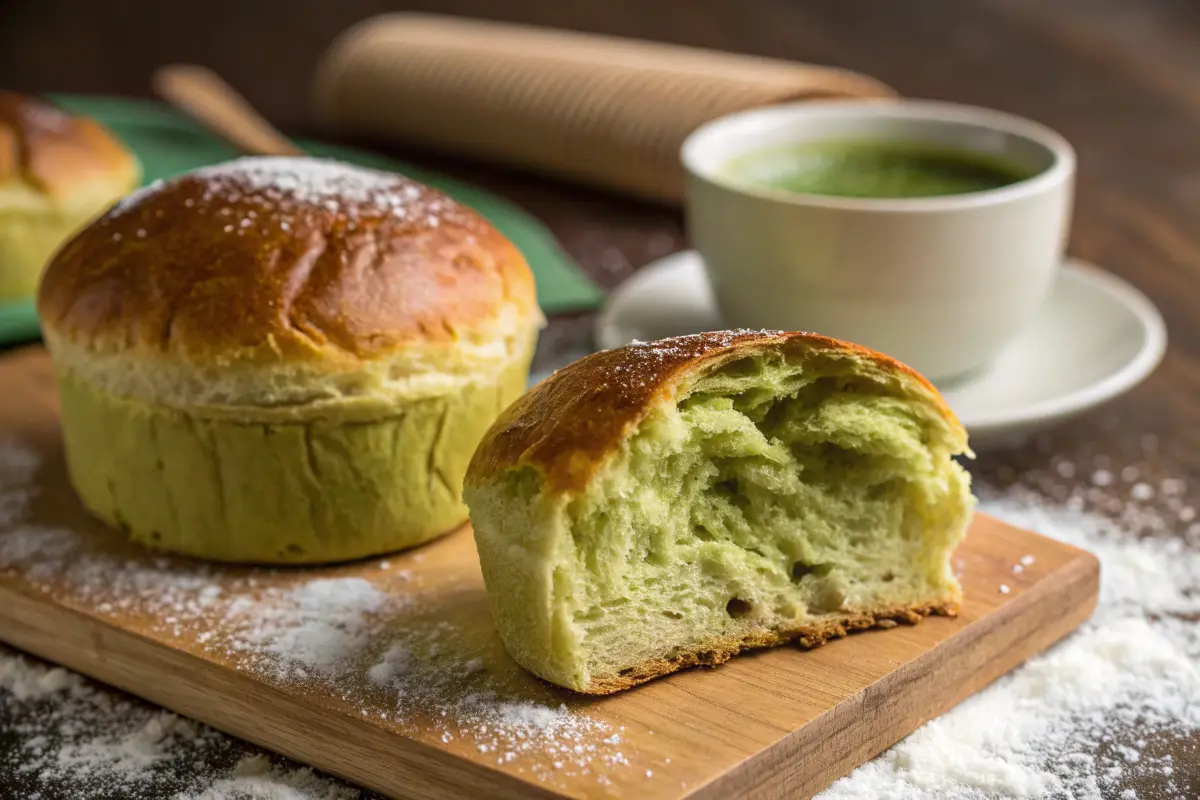Written by Sarah Miller
Matcha pan is a soft, fluffy bread infused with vibrant matcha green tea powder, giving it a distinctive earthy flavor and stunning green hue. Popular in Japanese bakeries and modern cafes, matcha pan combines the sweetness of bread with the slightly bitter, umami-rich taste of matcha.
This bread can be made in different styles, from sweet matcha milk bread to crispy melon pan with a matcha-flavored crust. Whether you’re a fan of matcha lattes, matcha desserts, or Japanese pastries, this recipe will show you how to make matcha pan at home.
For another delicious matcha-inspired treat, check out our Matcha Brownies Recipe for a rich, chocolatey take on matcha.
How to Make Matcha Pan Step by Step
Matcha pan is a delicious fusion of traditional Japanese baking and the rich, earthy notes of matcha. Whether you prefer a soft, fluffy matcha bread or a crispy matcha melon pan, this step-by-step guide will help you create the perfect loaf or bun at home.
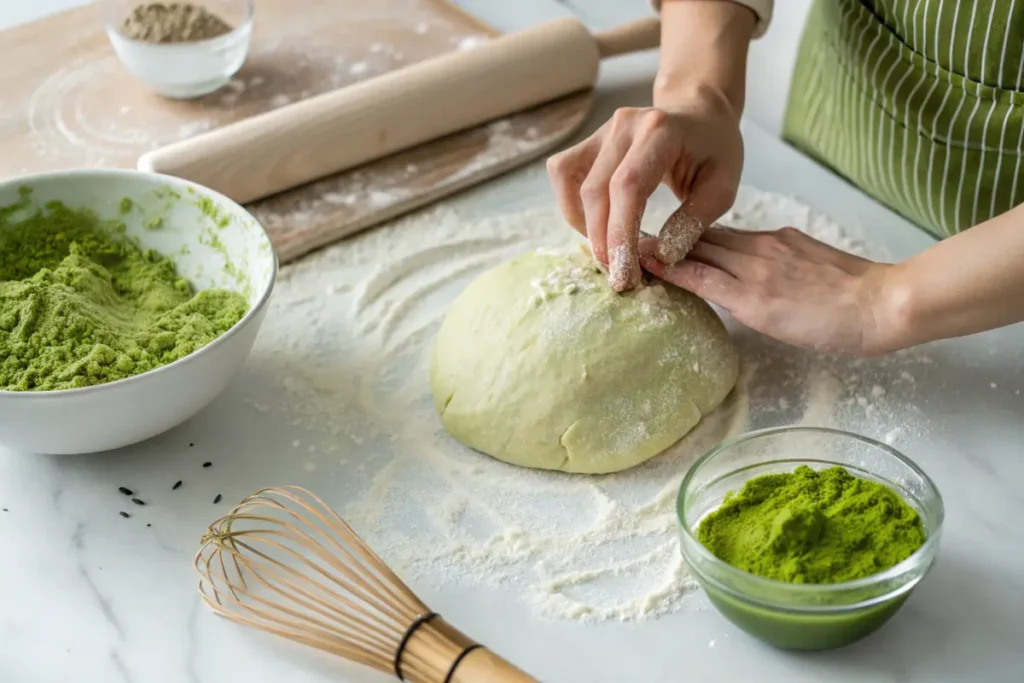
Ingredients for Matcha Pan
| Ingredient | Purpose | Substitutions |
|---|---|---|
| All-purpose flour | Provides structure for the bread | Bread flour for extra chewiness |
| Matcha powder | Adds flavor and color | Culinary-grade matcha for best results |
| Granulated sugar | Balances matcha’s natural bitterness | Honey or maple syrup for a natural alternative |
| Milk | Adds moisture and richness | Almond or oat milk for dairy-free |
| Butter | Makes the bread soft and flavorful | Coconut oil for a vegan version |
| Egg | Helps with structure and texture | Flax egg for an egg-free option |
| Yeast | Allows the dough to rise and become fluffy | Instant yeast for a faster rise |
| Salt | Enhances flavor and balances sweetness | No substitution needed |
Equipment Needed
| Equipment | Purpose |
|---|---|
| Mixing bowls | For combining ingredients |
| Stand mixer or hand mixer | Helps knead the dough more efficiently |
| Rolling pin | Rolls out dough evenly for shaping |
| Baking sheet | Holds the shaped dough for baking |
| Sifter | Ensures matcha powder is evenly distributed |
Step 1: Prepare the Dough
- In a small bowl, dissolve the yeast in warm milk and let it sit for 5–10 minutes until foamy.
- In a large mixing bowl, whisk together the flour, matcha powder, sugar, and salt.
- Add the yeast mixture, egg, and melted butter to the dry ingredients.
- Knead the dough for 10–12 minutes until it becomes smooth and elastic.
- Cover the dough with a damp towel and let it rise for 1–2 hours until doubled in size.
How to Shape and Bake Matcha Pan
Once the dough has risen, it’s time to shape and bake the matcha pan. There are multiple ways to prepare it, depending on whether you want soft matcha milk bread, matcha-filled rolls, or matcha melon pan with a crispy cookie topping.
Shaping Options for Matcha Pan
| Shape | Description | Best For |
|---|---|---|
| Matcha Milk Bread | A classic soft loaf, great for slicing | Sandwiches, toast |
| Matcha Dinner Rolls | Small, round, fluffy rolls | Individual servings |
| Matcha Melon Pan | A matcha bread bun covered with a crispy, sweet cookie crust | Bakery-style pastries |
| Matcha Swirl Bread | Layers of matcha and plain dough swirled together | Beautiful marbled effect |
Step 2: Shape the Dough
- Punch down the risen dough and transfer it to a lightly floured surface.
- Divide the dough into equal portions depending on the style you want.
- For matcha milk bread, roll the dough into a rectangle and place it in a greased loaf pan.
- For matcha rolls, shape small balls of dough and place them on a baking sheet.
- For matcha melon pan, prepare a separate cookie dough by mixing butter, sugar, flour, matcha, and egg. Flatten small pieces of cookie dough and wrap them over each bread roll.
Step 3: Second Rise and Baking
- Cover the shaped dough and let it rise again for 30–45 minutes.
- Preheat the oven to 350°F (175°C).
- Brush the tops of the bread with milk or egg wash for a golden finish.
- Bake for 20–25 minutes or until the tops are lightly golden and the bread sounds hollow when tapped.
- Let the matcha pan cool completely before slicing or serving.
Different Variations of Matcha Pan
Matcha pan can be customized in several ways to suit different tastes and textures. Whether you love a classic soft loaf or want a unique filling, there are plenty of ways to experiment with this flavorful bread.
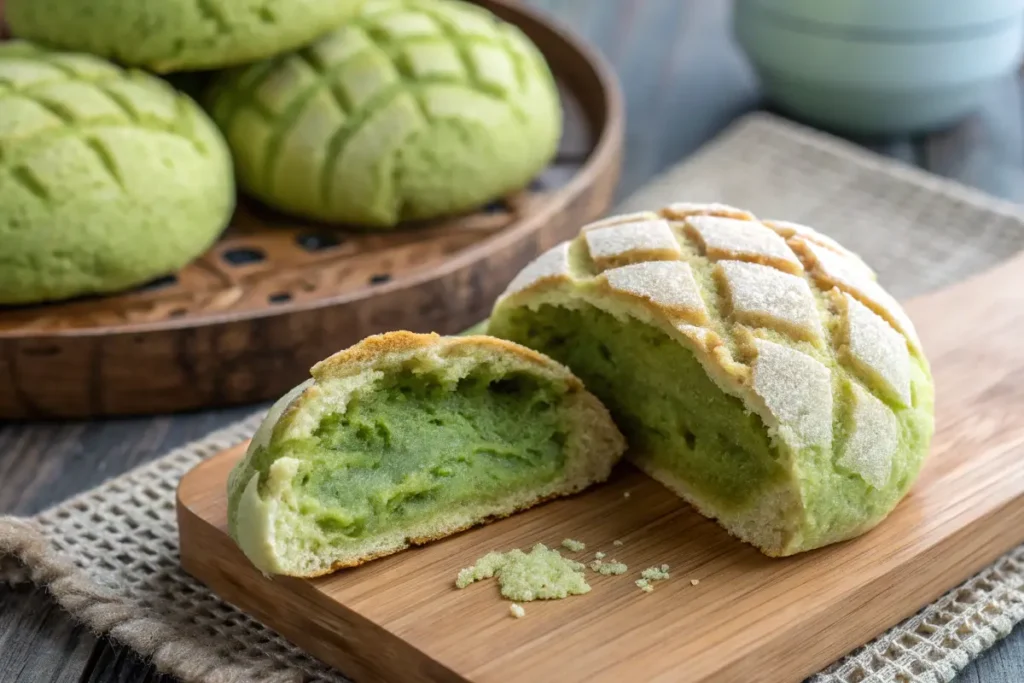
Popular Variations of Matcha Pan
| Variation | Description | Best Served With |
|---|---|---|
| Matcha Red Bean Pan | Soft matcha bread filled with sweet red bean paste | Green tea or coffee |
| Matcha White Chocolate Pan | Bread with melted white chocolate chunks inside | Breakfast or dessert |
| Matcha Black Sesame Pan | A nutty twist with black sesame paste swirled into the dough | Butter or cream cheese |
| Matcha Custard Pan | Bread filled with vanilla or matcha custard cream | Afternoon tea |
| Matcha Melon Pan | A crispy cookie-covered matcha bread roll | Sweet treats or snacks |
How to Add Fillings to Matcha Pan
- Roll out a small portion of dough into a circle.
- Place 1-2 tablespoons of filling (such as red bean paste, custard, or chocolate) in the center.
- Fold the edges over and pinch to seal the filling inside.
- Shape the dough into a round bun and let it rise before baking.
Best Food and Drink Pairings for Matcha Pan
Matcha pan has a unique balance of sweetness and earthy bitterness, making it a versatile bread that pairs well with both savory and sweet flavors. Whether you’re enjoying it as a snack, breakfast, or dessert, the right pairing enhances the overall taste experience.
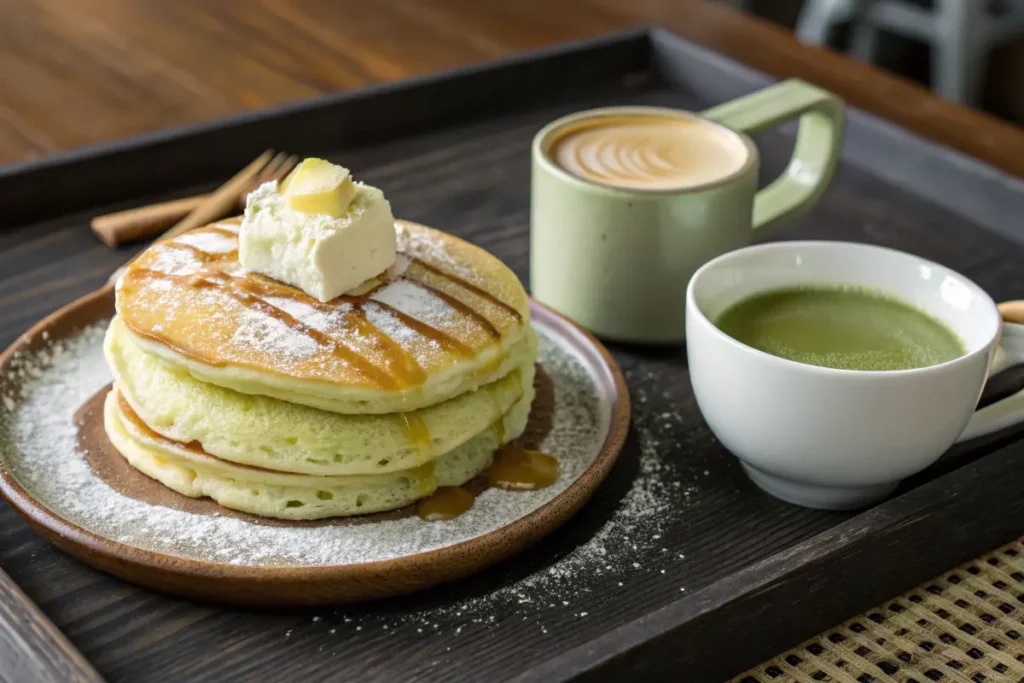
Best Drinks to Pair with Matcha Pan
| Drink | Why It Works |
|---|---|
| Matcha Latte | Complements the matcha flavor while adding creaminess |
| Hojicha Tea | The roasted, nutty notes contrast beautifully with sweet matcha bread |
| Black Coffee | The bold bitterness balances the subtle sweetness of matcha pan |
| Milk Tea | The richness of milk tea enhances the bread’s soft texture |
| Hot Chocolate | A sweet and indulgent contrast to matcha’s earthy taste |
Best Foods to Serve with Matcha Pan
| Food | Why It Works |
|---|---|
| Whipped Cream & Berries | Adds sweetness and freshness to contrast the bread’s richness |
| Butter & Honey | Enhances the soft texture with a creamy, sweet touch |
| Almond Butter | A nutty spread that pairs well with matcha’s earthiness |
| Cheese (Brie or Cream Cheese) | The mild tanginess complements matcha’s slight bitterness |
| Eggs & Avocado | A savory pairing that works well for breakfast |
For an indulgent experience, try toasting matcha pan and spreading it with sweet red bean paste or mascarpone cheese.
Common Mistakes to Avoid When Making Matcha Pan
Even though matcha pan is relatively easy to make, small mistakes can affect its texture, flavor, and appearance. Avoid these common errors to ensure a soft, flavorful, and perfectly baked bread.
Top Mistakes When Making Matcha Pan
| Mistake | Why It’s a Problem | How to Fix It |
|---|---|---|
| Using Low-Quality Matcha | Results in a dull color and weak flavor | Use culinary-grade matcha for vibrant color and taste |
| Adding Too Much Matcha | Can make the bread overly bitter and dry | Stick to 1-2 tbsp per batch for balance |
| Not Kneading the Dough Enough | Leads to dense and chewy bread | Knead for at least 10-12 minutes until smooth |
| Skipping the Second Rise | The bread won’t be light and fluffy | Let the dough rise again for 30-45 minutes before baking |
| Overbaking | Dries out the bread and reduces matcha’s flavor | Bake at 350°F (175°C) and check at 20 minutes |
| Not Sifting the Matcha | Causes clumps in the dough | Always sift matcha powder before mixing |
By following these tips, your matcha pan will turn out soft, fluffy, and perfectly infused with matcha flavor.
How to Store and Reheat Matcha Pan for Freshness
Proper storage helps maintain the softness and flavor of matcha pan, ensuring it stays fresh for days. Whether you plan to enjoy it immediately or save it for later, following these storage methods will keep your bread moist, fluffy, and delicious.
Best Ways to Store Matcha Pan
| Storage Method | How to Store | Shelf Life |
|---|---|---|
| Room Temperature | Keep in an airtight container or wrapped in plastic wrap. | 2–3 days |
| Refrigerator | Store in a sealed bag or container to prevent drying. | Up to 1 week |
| Freezer | Wrap in plastic wrap and place in a freezer-safe bag. | Up to 2 months |
Tip: Avoid storing matcha pan in the refrigerator unless necessary, as it can dry out the bread faster.
Best Ways to Reheat Matcha Pan
| Method | How to Reheat | Best For |
|---|---|---|
| Toaster | Toast for 1-2 minutes until warm and slightly crispy. | Sliced matcha bread |
| Microwave | Wrap in a damp paper towel and heat for 10-15 seconds. | Soft rolls or filled buns |
| Oven | Warm at 300°F (150°C) for 5-7 minutes. | Whole loaves or larger portions |
For the best flavor, brush reheated matcha pan with a little butter or honey before serving.
Frequently Asked Questions About Matcha Pan
Is Matcha Pan Healthier Than Regular Bread?
Yes! Matcha pan contains antioxidants, L-theanine, and less sugar than many commercial breads. Using whole wheat flour or reducing sugar can make it an even healthier option.
Can I Make Matcha Pan Without Dairy or Eggs?
Absolutely! Use plant-based milk (almond, oat, or coconut) and flaxseed or chia eggs as substitutes. Swap butter for coconut oil to make it completely vegan.
Why Is My Matcha Bread Dry?
Over-kneading, not adding enough fat (butter or oil), or overbaking can dry out matcha pan. Make sure to measure ingredients carefully and check for doneness around the 20-minute mark.
Is Starbucks matcha really matcha?
Starbucks matcha contains sweetened matcha powder, which is a blend of green tea powder and sugar. Unlike pure ceremonial-grade matcha, it has added sweeteners and fillers that dilute the authentic matcha experience. If you’re looking for real matcha flavor, opt for culinary or ceremonial-grade matcha from trusted sources.
Why is matcha so expensive?
Matcha is labor-intensive to produce and requires hand-picking, shading, and stone-grinding of high-quality green tea leaves. Japanese matcha, especially from Uji and Nishio, is known for its superior flavor and color, making it pricier than regular green tea.
Why is Japanese bread so fluffy?
Japanese bread, including shokupan and matcha pan, is fluffy due to the Yudane or Tangzhong method, where a portion of flour is pre-cooked with water or milk before being mixed into the dough. This technique enhances moisture retention, creating a soft, pillowy texture.
Does heat destroy matcha?
Excessive heat can reduce matcha’s antioxidants and degrade its vibrant color. It’s best to use warm (not boiling) water when preparing matcha-based drinks and recipes. When baking with matcha, lower oven temperatures (325-350°F) help preserve its flavor and nutrients.
Is matcha healthier than coffee?
Yes, matcha contains less caffeine than coffee but provides a longer-lasting energy boost due to L-theanine, which promotes calm alertness without crashes. It also has more antioxidants than coffee, making it a better option for sustained energy and health benefits.
What not to mix with matcha?
Avoid mixing matcha with boiling water, artificial sweeteners, excessive dairy, and citrus juices, as they can alter its flavor, degrade its nutrients, or overpower its delicate umami taste. Instead, pair matcha with natural sweeteners, plant-based milk, and mild flavors to enhance its unique profile.
Final Thoughts on Matcha Pan
Matcha pan is a unique and flavorful bread that blends the earthy richness of matcha green tea with the soft, fluffy texture of freshly baked bread. Whether you enjoy it as a sweet treat, a breakfast staple, or a bakery-style dessert, this bread offers a delicious fusion of Japanese flavors and Western baking techniques.
Why You Should Try Making Matcha Pan
| Reason | Why It’s Great |
|---|---|
| Easy to Make | Uses simple ingredients and baking techniques. |
| Rich in Antioxidants | Matcha provides natural health benefits like boosting energy and metabolism. |
| Versatile | Can be made into loaves, rolls, or filled buns. |
| Customizable | Add fillings like red bean paste, white chocolate, or custard. |
| Pairs Well with Drinks | Perfect with matcha lattes, coffee, or hojicha tea. |
Serving and Storage Recap
- Serve warm with butter, honey, or fresh fruit for extra flavor.
- Store in an airtight container for 2-3 days at room temperature or freeze for up to 2 months.
- Reheat in a toaster or oven for the best texture.
For more matcha-inspired recipes, check out these delicious options:
- Matcha Brownies Recipe – A rich, chocolatey take on matcha.
- Strawberry Puree Recipe – A perfect topping for sweet matcha pan variations.
- Cottage Cheese Pizza Crust – A unique savory baking idea.
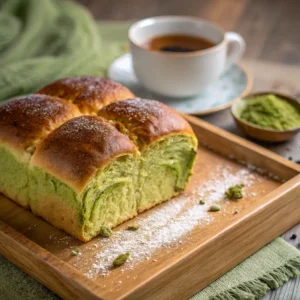
Matcha Pan
Equipment
- Mixing bowls
- Stand Mixer or Hand Mixer
- Rolling pin
- Baking sheet
- Sifter
Ingredients
Matcha Bread Dough
- 2 cups all-purpose flour Can substitute with bread flour for extra chewiness
- 1 tbsp matcha powder Use culinary-grade matcha for best results
- 1/4 cup granulated sugar Can substitute with honey or maple syrup
- 1/2 tsp salt
- 1 cup warm milk Almond or oat milk for dairy-free option
- 2 tsp instant yeast For faster rise
- 1 egg Flax egg for an egg-free option
- 3 tbsp unsalted butter Coconut oil for a vegan version
Instructions
- Dissolve the yeast in warm milk and let it sit for 5–10 minutes until foamy.
- In a large bowl, whisk together the flour, matcha powder, sugar, and salt.
- Add the yeast mixture, egg, and melted butter to the dry ingredients.
- Knead the dough for 10–12 minutes until it becomes smooth and elastic.
- Cover the dough with a damp towel and let it rise for 1–2 hours until doubled in size.
- Punch down the risen dough and transfer it to a lightly floured surface.
- Shape the dough according to your preferred style: loaf, rolls, or melon pan.
- Cover the shaped dough and let it rise again for 30–45 minutes.
- Preheat the oven to 350°F (175°C).
- Brush the tops of the bread with milk or egg wash for a golden finish.
- Bake for 20–25 minutes or until lightly golden and sounds hollow when tapped.
- Let the matcha pan cool completely before serving.
